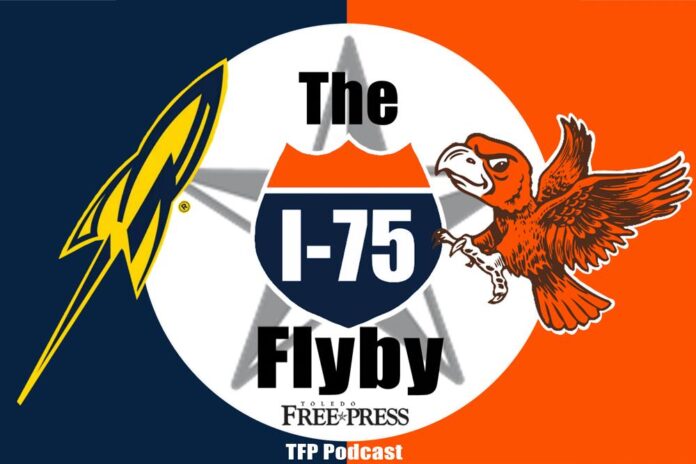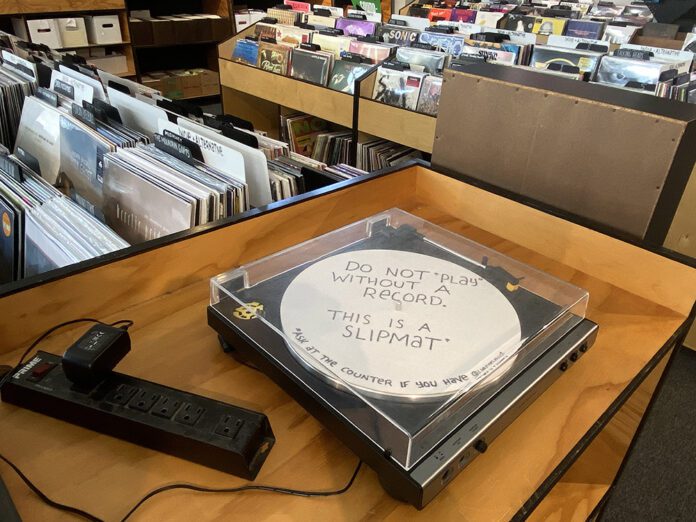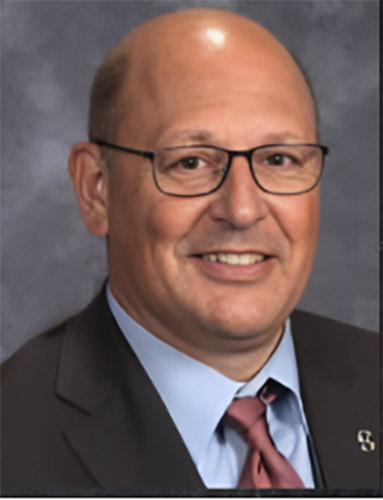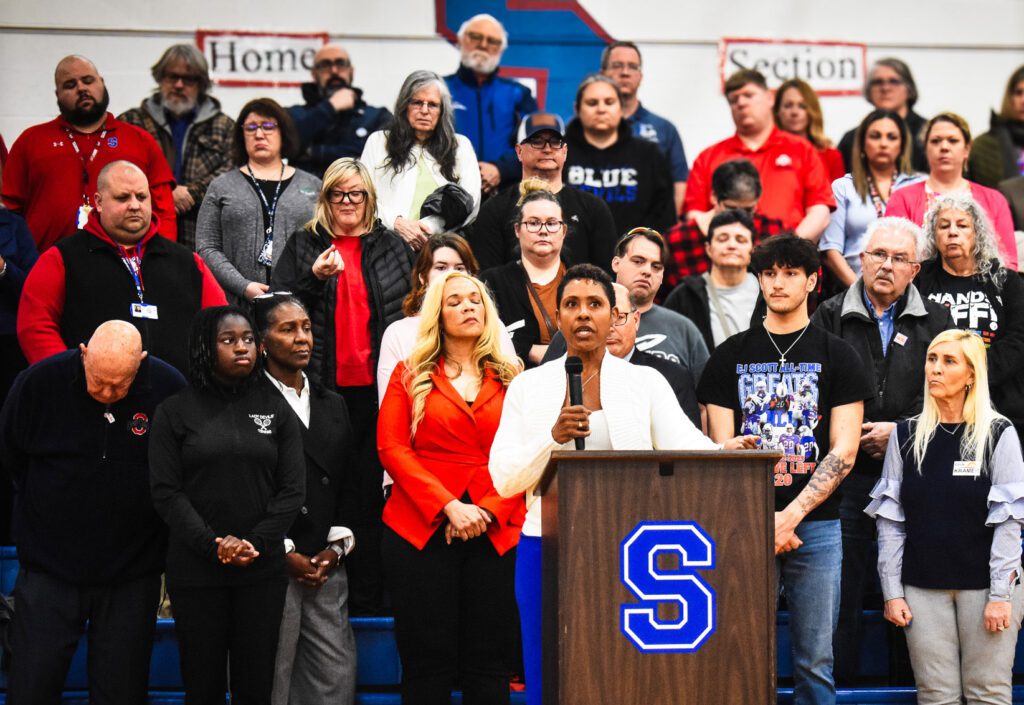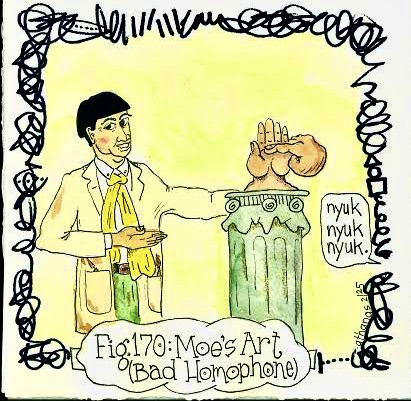The Flyby Farewell Episode
On this episode of the Flyby Sports Podcast, co-hosts Chas McNeil and Max Alfonso bid farewell to the podcast as they chat one last time about all things Falcons and Rockets athletics.
Both students are spring 2025 interns with the Toledo Free Press (TFP) and graduate in May. Their last day at the newsroom was Friday, April 11, and their competitive banter will be missed.
Listen as they talk about:
- NFL draft and MAC portal gains and losses … and BGSU men’s basketball lost a lot
- MAC portal exchanges within the MAC
- UToledo women’s basketball gains a 6’4″ ‘athletic’ MAC transfer
- their experience of creating and hosting their first podcast
- mutual kudos to the TFP staff
- possible story and podcasting opportunities with the TFP in the near future
Good luck Chas and Max! We wish you luck as you fly away into the great unknown …
The Flyby Sports Podcast is a production of the Toledo Free Press and will be always be available in the TFP Pod Station page.
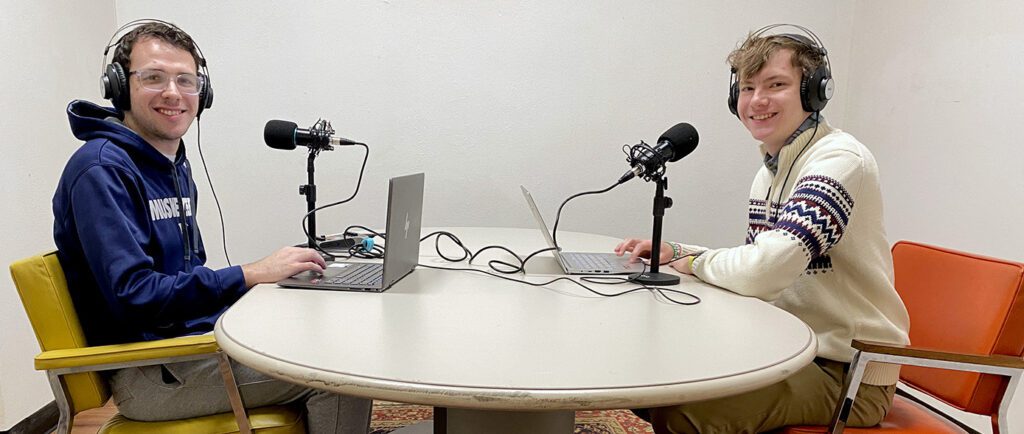
Ohio universities respond to SB 1, DEI crackdown
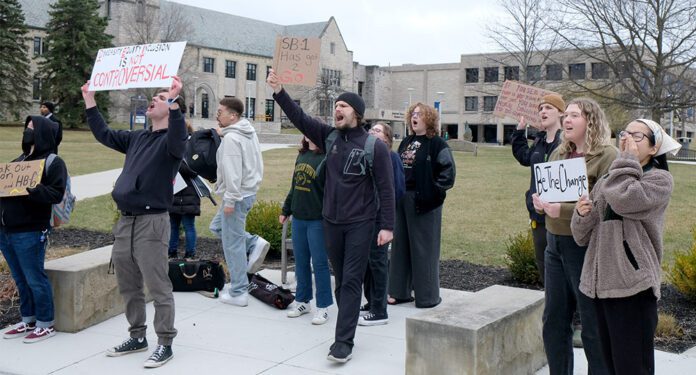
TOLEDO – Political science major Ty Moussa held a Palestinian flag as he stood among nearly 175 University of Toledo students, faculty and staff who had gathered in the heart of Centennial Mall to protest SB 1.
It was March 20, and at that point, SB 1, officially known as the Advanced Ohio Higher Education Act, had passed through the Ohio House of Representatives just one day before the rally, with an expectation that Ohio Gov. Mike DeWine would sign it.
“I’m here to protest against the silencing of anybody who wants to say anything in this country,” said Moussa, originally from Lebanon. “It’s an absolute right since the foundation of this nation that we have the right to freedom of speech, the right to assemble, and the right to freedom of speech inside of our classrooms.
“It affects me by silencing me. If I’m not allowed to say what I believe in, then what’s the point of this nation’s First Amendment and the constitution?” he asked. “I think SB 1 is totally against that.”
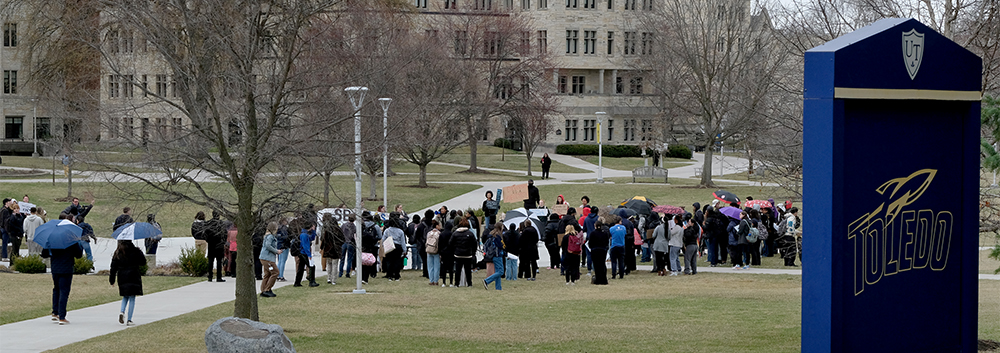

Moussa, who fears SB 1 will eliminate DEI measures, predicted that if the bill ends up becoming Ohio law, the university will yield to the government’s plans because “history has shown that universities will end up folding to the government, even if they try to fight, because they need the funding.”
University responses
One of the first universities to fold due to the Trump administration’s threat of taking away that funding was The Ohio State University (OSU). In late February, OSU President Ted Carter ordered that the university close two DEI offices and fire 16 staffers.
When the Toledo Free Press reached out to the University of Toledo (UT) for a comment on their plans for DEI, the administration “declined to comment at this time.” But it’s worth noting that the UT Office of Diversity, Equity and Inclusion ‘team’ was recently cut down to one – its director, Dr. Malaika Bell.
According to Aleiah Jones, director of UT’s Office of Multicultural Student Success, the university will abide by all state and federal laws and legislation. However, Jones said she hopes there is grace and empathy for people who are navigating through the changes universities must adhere to as they follow the law.
“I think they [students and faculty] are doing their best to inform themselves and share that information, so we saw that with the rally that they hosted,” Jones said. “They’re also supporting each other; I am really proud of the ways students are coming together to continue to grow and build each other up. We know that will continue to happen and that everyone will do their best to navigate the changes that we may face.”
Jones added that her office takes pride in being a safe and welcoming space on campus, and will continue to do so.
And as for a response to SB 1 by BGSU President Rodney K. Rogers, he penned a letter to students the same day it passed through the Ohio legislature on March 26. Here are portions of that letter:
“Today, elected representatives in the Ohio Legislature passed Senate Bill 1, which establishes broad implications for Ohio’s public institutions of higher education specific to diversity, equity and inclusion, among other topics. If you have not yet read SB1, The Advance Ohio Higher Education Act, I encourage you to do so. The bill now goes to Gov. Mike DeWine, and if signed into law, provisions will begin to take effect in 90 days.
“SB1 also codifies into state law many of our core educational principles: free speech in our classrooms, academic freedom and opportunity for all. Let me be clear – we unequivocally agree, as the bill states, that institutions of higher education should, ‘treat all faculty, staff, and students as individuals, hold every individual to equal standards, and provide those individuals with equality of opportunity, with regard to those individuals’ race, ethnicity, religion, sex, sexual orientation, gender identity, or gender expression.‘
“In the coming weeks, we will offer opportunities for members of the campus community to share their thoughts and participate in discussions regarding the implementation of SB1. I encourage you to engage in this process, as this feedback will be particularly valuable for understanding the impact of the law on the operations of the University.”
The driving force behind SB 1
The ending of DEI (Diversity, Equity and Inclusion) policies is certainly one of the driving forces behind the bill. Jerry Cirino (R-Kirkland), the bill’s sponsor, made it clear in an Ohio Senate News bulletin what his intentions were – to limit liberal bias and ban all diversity, equity and inclusion (DEI) programs, courses and mandatory training on college campuses.
“My bill will return our public universities and colleges to their rightful mission of education rather than indoctrination,” Cirino stated. “We also must return to teaching students how to think rather than what to think, and how to listen to opposing views with a respectful but critical ear.”
The evolution of DEI in the workforce was born in the late 1950s and ‘60s, when the government began moving toward federally protected equal rights for all Americans.
Title VI of the Civil Rights Act of 1964, as outlined in the Department of Justice’s Civil Rights Division website, states that “all persons must be treated equally without regard to their race, color, or national origin. People may not be excluded from participating in, denied the benefits of, or discriminated against in the programs, services, or activities of an agency receiving DOJ assistance.”
The momentum of DEI progressed over the next few decades. In 1990, the Americans with Disabilities Act (ADA) was passed, and in 2020 the Supreme Court expanded the definition of employment discrimination to include sexual orientation and gender identity.
But when President Donald Trump took office in January, that momentum came to a screeching halt. On Feb. 14, the U.S. Department of Education (which is also in danger of being shut down) ordered public universities to end all DEI programs by March 1 or risk losing federal funding.
So, with a stroke of a pen on March 28, DeWine complied and poked a hole in the safety net that many Ohio university students, faculty and staff depend on to feel safe and equal.
The bill, which becomes law 90 days after he signed it, will affect policies related to hiring practices, faculty strikes and free speech in the classroom.
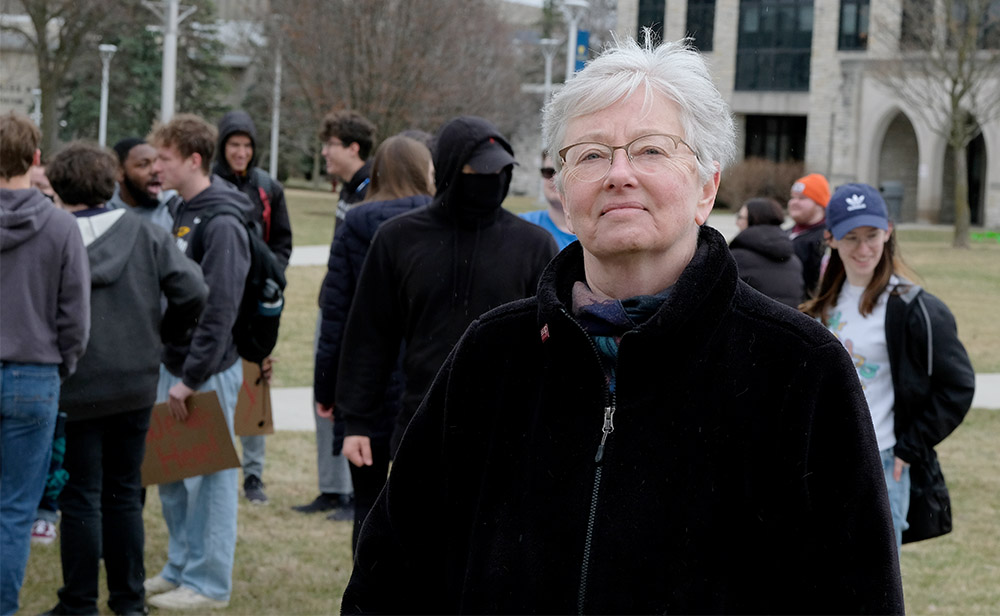
And that worries University of Toledo French teacher Dr. Linda Rouillard.
Surrounded by protestors with signs that read “SB 1 has got 2 Go,” “Looking for America” and “SB 1 is so CRINGE,” Rouillard said this bill “destroys academic freedom in our universities, and it also destroys free speech because it outlines specific topics that must not be discussed in the classroom.
“How are STEM students going to be prepared for healthcare jobs if they haven’t had discussions about the disparities between white women and black women in childbirth in the classroom?” asked Rouillard, who is involved in the faculty Senate and a supporter of UT AAUP (University of Toledo Chapter of the American Association of University Professors).
“How are they going to be prepared to deliver the best treatments for patients suffering respiratory illnesses due to climate change? Students aren’t going to come here to study in Ohio if they know this is the climate they’re walking into. I strongly oppose SB 1,” she declared.
Rouillard pointed out that despite more than 900 submitted written testimonies and 200 people showing up to the Ohio Senate hearing on Feb. 11 to testify against SB 1, as well as about 97,000 signatures on an online petition, DeWine still signed the controversial bill, which basically overhauled higher education throughout the state.

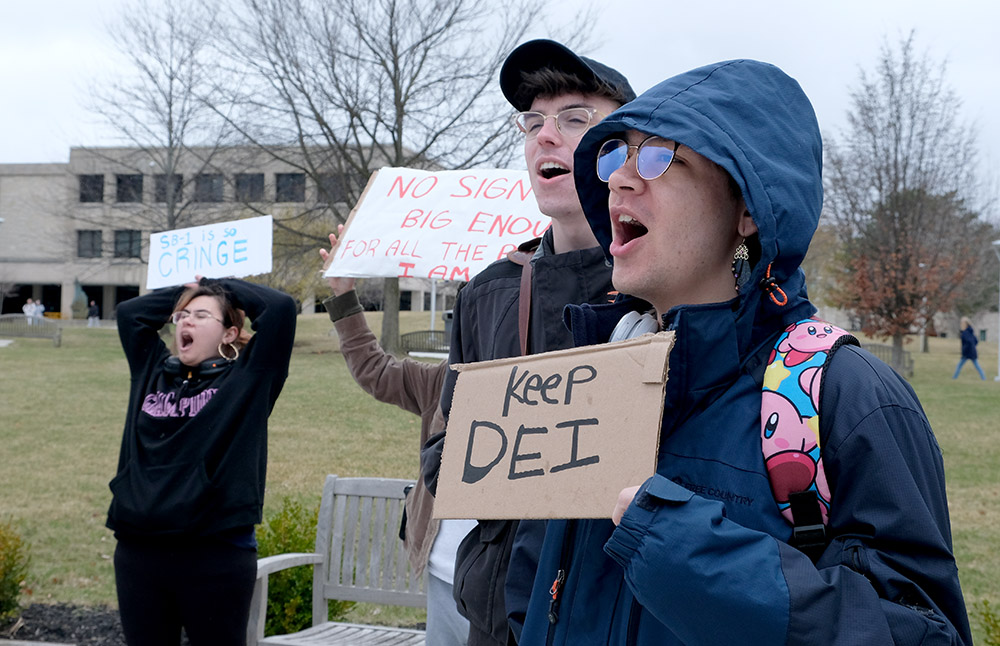
Rouillard’s fears seemed to be warranted. On Tuesday, the Trump administration froze over $1 billion in funding for Cornell University and $790 million for Northwestern University while it investigates both schools over civil rights violations.
According to an April 9 USA Today article, the administration threatened to block federal funding for schools over pro-Palestinian campus protests, as well diversity, equity and inclusion programs and transgender policies. And last Friday, the Supreme Court granted the administration’s plea to cut hundreds of millions of dollars in teacher-training money as part of its anti-DEI efforts while a lawsuit continues, according to a WTOL story.
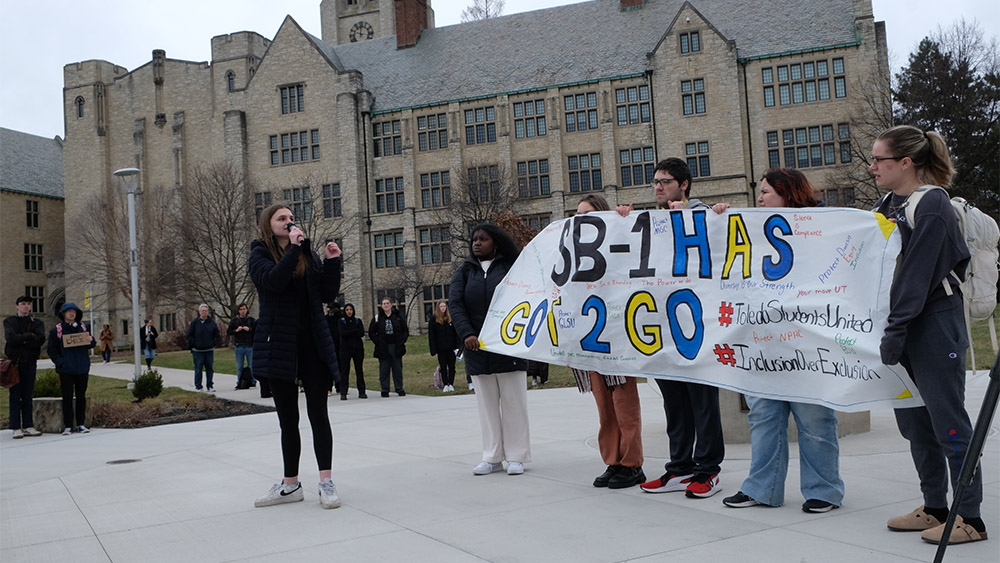
Jordan Tracy, a UToledo political science major on a pre-law track and the director of government relations for student government, said the student government planned the March 20 rally “to make sure we’re mobilizing our student body. For the fact we got about 150 to 200 students … I could not be happier with how that turned out.
“We are the ones that kind of took this project on, considering that a lot of our students on campus expressed that this was an issue they wanted to address and to make sure we’re mobilizing our student body,” Tracy said.
I think that students resonate with the message that we want the university to commit to making sure that we’re still funding and providing opportunities and supporting our diversity equity inclusion campus culture in addition to our identity-based scholarships in any speech courses that are related to that as well.
Jordan Tracy | University of Toledo director of government relations for student government.
These are a few of the changes to take effect 90 days after DeWine signed the bill:
- Syllabi posting: Instructors will be required to post the professor’s course outline for each undergraduate class beginning in the 2026-27 school year. Each document must include what topics will be covered as well as any relevant readings. Instructors must also share their qualifications and contact information. Class meeting locations or times don’t have to be included. It’s the first time this type of requirement has been broadly implemented in Ohio.
- Faculty evaluations: Annual student evaluations — already happening at most schools — now must include a question asking if the classroom atmosphere is free of political, racial, gender and religious bias.
- Post-tenure review: Faculty members who earn tenure at their universities can only be fired for cause or under “extraordinary” circumstances. It’s a big part of academic life. Tenured professors in Ohio are already reviewed by their universities on a regular basis.
- Mandatory civics course: A new three-credit course, American civic literacy, will be a requirement for those pursuing a bachelor’s degree beginning in the 2029-30 school year. Implementing this course won’t come cheap. Cleveland State University officials estimated it’ll cost about $400,000 to launch the course there.
- Speaker transparency: Institutions will create a searchable online database of any speakers who were paid more than $500. Users will need to access this information in three clicks or less from a university’s main homepage. Some campus speakers have received public pushback in recent years.
- Five-year cost reports: Universities will produce new comprehensive reports outlining their five-year costs for lawmakers to consider ahead of the state’s operating and capital improvement budgets. These detailed reports will focus on costs related to things such as student instruction and instructor and staff salaries. Institutions will also have to note how many people they employ and how much they spent on diversity, equity and inclusion “or related subjects.”
- Trustee training: Universities will work with the Ohio Department of Higher Education to create new training programs for boards of trustees. The instruction will include outlining board members’ responsibilities and reviewing current higher education trends.
New trustees will have to participate in these sessions at least once during the first two years of their term, though they can do so virtually. Current trustees will have to participate “at levels to be determined by the chancellor [of higher education],” the bill says. - Three-year program study: ODHE will conduct an in-depth feasibility study looking at if colleges could offer some bachelor’s degree programs in three years instead of four. A report must be produced within a year of the study being done. (Source: Signal Cleveland)
Culture Clash celebrates Record Store Day April 12
TOLEDO – Culture Clash Records has been a staple of the Toledo music scene for decades. The establishment hosts a vinyl store that caters to all genres of music for every imaginable audience.
It’s long since doubled as a venue, hosting a wide swath of local acts, but the last eight years have been a challenge for the business. The location and some staff have moved, the company had to adjust to a new space, and there was a change in ownership – all the while, the demand for vinyl soared.
Tim and Lizzie Friedman, owners of Culture Clash, spoke with the Toledo Free Press about their winding journey. Tim Friedman has seen a drastic difference from their beginnings in 2017, when they purchased the business, followed by their move to the current downtown space (at 912 Monroe St.) in 2020, and then bought the building a year later.
“Talk about the landscape changing since 2016…everything is different. When I took over, it was most common to sell used $8 rock records. Now, we sell a robust variety of things. Our best sellers are Rumors by Fleetwood Mac, but alongside that we are selling Taylor Swift and Chappell Roan,” said Tim Friedman. “We’ve seen a significant shift of people walking through the door, from parents dragging their kids along to kids dragging their parents along.”
“The age of the average customer has gone down,” Lizzie Friedman added. “Especially as it’s gotten more popular and accessible for young people. Most of our customers are college age or younger.”
The resurgence of physical audio media has changed what’s stocked on the shelves, as well as the clientele. The heart of the store, however, remains the same. Customers come to Culture Clash because they know they have someone looking out for their taste. Bring up an artist you love, and you’ll get thorough recommendations. Looking for something special? They’ll keep an eye out for you. The current and past owners echo these sentiments. Most importantly, people feel welcomed here.
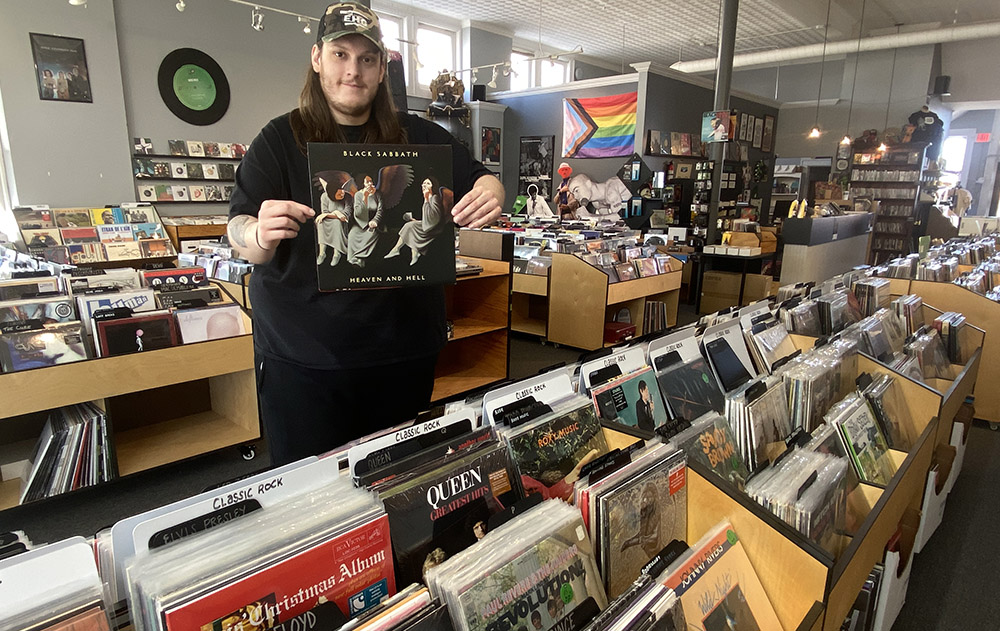
“The point of the store is to be available for everyone. We need to cater to the diversity of music that comes in here,” said Lizzie Friedman.
Jon Zenz, a former patron of Culture Clash’s previous iteration, Boogie Records, commented on his warm experiences here. Zenz, a musician, has also played at both the Secor location and their new downtown store.
“It was always the best place to get records,” he said. “Pick Pat’s brain on new stuff and he would always know what you liked. They had shows there and it was the best.”
The purchase of the downtown building in 2021 was intentional for expanding the legacy of Culture Clash.
“The purchasing of the new building has clouded this vision” said Tim Friedman. “We’ve had to pivot time and again because of what’s needed of us.”
The venue hasn’t hosted shows at the frequency they had in their Secor location days. The delay has been tough to swallow. Shows, or “in-stores,” have been part of their mission to integrate with the tri-state music scene. The goal is exposure and keeping the music going; the stage is open to musicians with a range of experience.
Tim Friedman said, “We encourage artists as a DIY space, where they can sell tickets ahead of time and at the door. We say this low-dollar amount from your ticket sales goes towards us being able to continue doing this. It covers the costs.”
In-stores weren’t hosted until very recently because of building capacity requirements and zoning restrictions that prevented concerts from taking place. The building’s change in ownership came with changes in requirements, creating an unforeseen barrier.
“We spent a couple of years and tens of thousands of dollars determining what the city wanted from us. We worked with architects who went back and forth with a building official who no longer works for the city.”
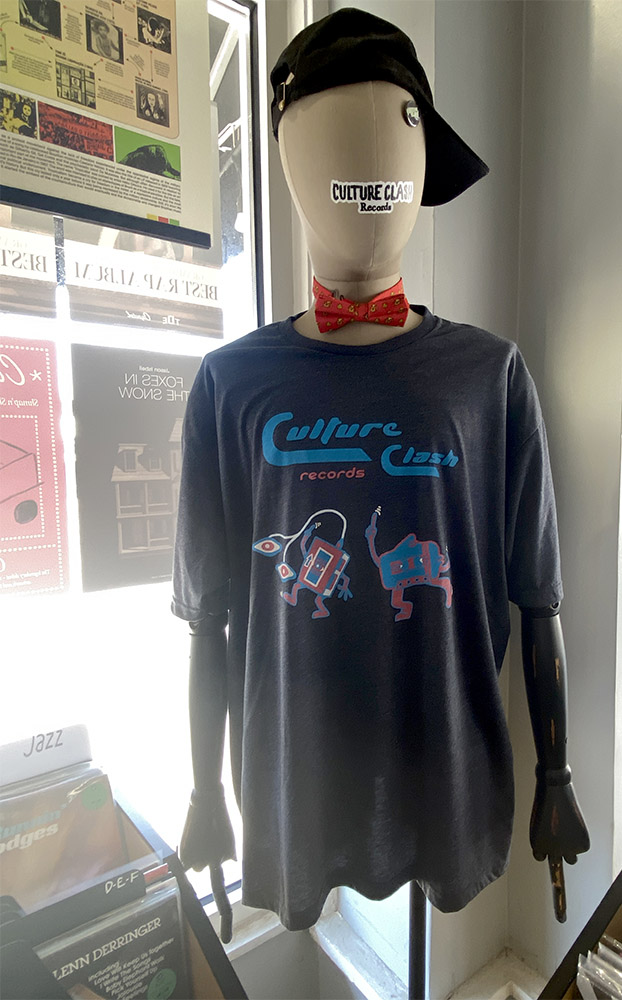

Eventually, the expenses of their endeavor to fully realize the space came to a tipping point. “We had to ask for help last year, it got so ugly,” said Tim Friedman. “Not unrelated to the tens of thousands of dollars we spent on this building. It’s so difficult to ask for that help. It feels like saying we messed up, and I don’t think that’s true.”
Record Store Day 2024 was a huge success for Culture Clash. According to Liz Friedman, “we didn’t go public with the need for help until October of 2024, and then we hosted a big “Save Culture Clash” fundraiser event in November, which was a similar set up to RSD — all day party with music, vendors and food trucks.”
This year, Record Store Day 2025 is on April 12, and it’s expected to be another all-day party.
Live music? Yes! In-stores are once again available in the space. Other adjustments were made to resolve building restrictions, and now events land on the schedule more frequently.

“We’ll open at 10 and let 10 people in at a time,” said Tim Friedman. “We’ll have live music starting at that time. Live jazz followed by a singer/songwriter, DJ until noon. We’ll have hip-hop, Americana and indie rock, some more jazz. Hardcore to close out the night.”
This year’s Record Store Day feels like a celebration of overcoming obstacles alongside their community.
“We get to live our dream,” Tim Friedman said. “This has been a struggle to get to the point where we can maximize the space. There’s been a lot of great community and feedback. The response and the support has been wonderful.”
John Contos, a lifelong record collector and an employee at the store, said that “whether it’s a special release that brings people out [for Record Store Day], or seeing local artists play, it’s a pleasure to see the ever-expanding community of collectors coming out every year.”

Meta builds data center in Wood County
BOWLING GREEN – Meta is building an $800 million data center that will be optimized for AI to connect Facebook and Instagram users around the world, officials announced Wednesday at a news conference held in Bowling Green State University’s Bowen-Thompson Student Union.
Construction has already begun on the 280-acre site in Middleton Township on State Route 582, between U.S. 20 and I-75. The data center is expected to be fully operational sometime in 2027.
“We selected Middleton Township for a number of reasons, including great access to infrastructure and renewable energy, a strong pool of talent, and a wonderful set of community partners that have helped us move this project forward,” said Brad Davis, Meta’s director of data center community and economic development.
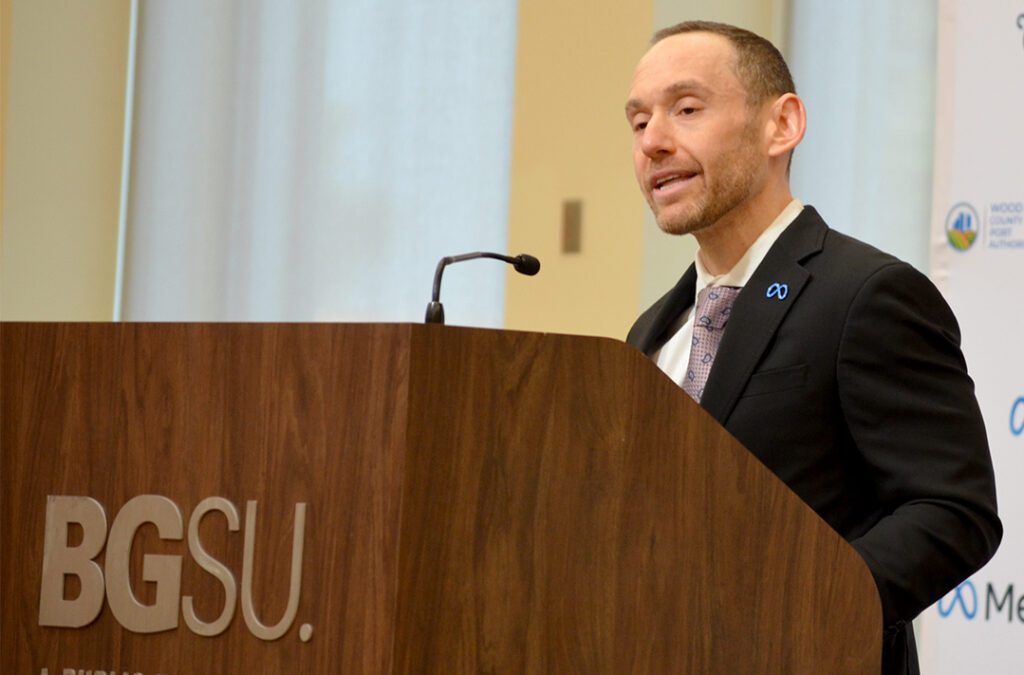
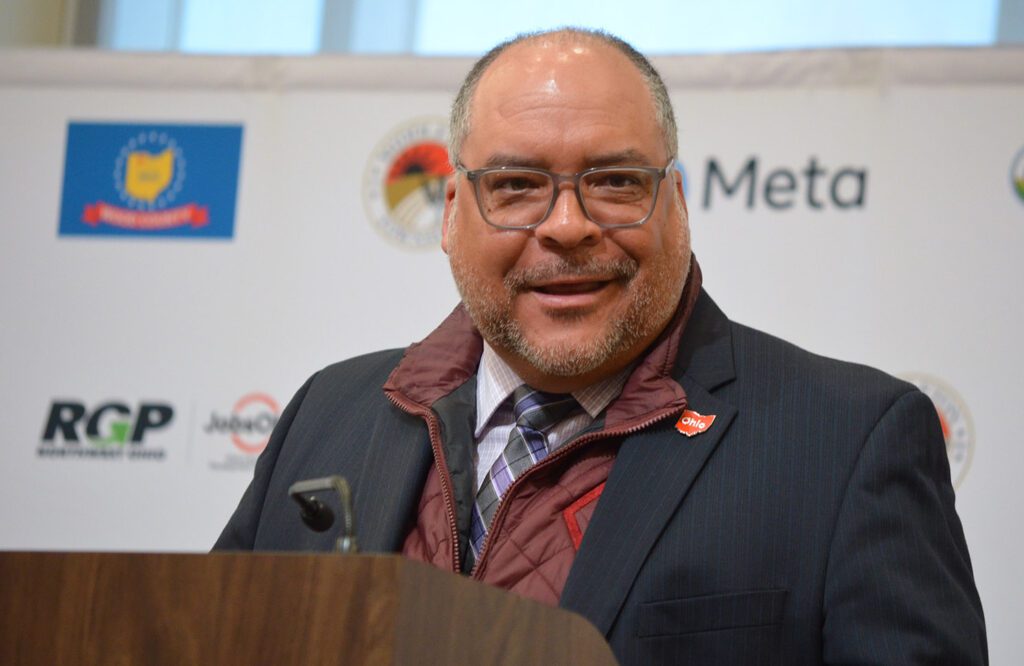
The 715,000-square-foot data center will be Meta’s 24th in the United States and 28th worldwide. It is expected to employ 100 workers with an average salary of slightly more than $83,000, according to Jonathan Bridges, managing director of JobsOhio.
The construction is expected to employ about 1,000 workers, officials said, and work will continue even after the facility opens.
“Unlike traditional manufacturing facilities, which complete construction in one or two years, data centers require continuous updates and equipment refreshing every two to three years,” Bridges noted. “This ongoing modernization means a sustained cycle of construction, technical support and jobs.”
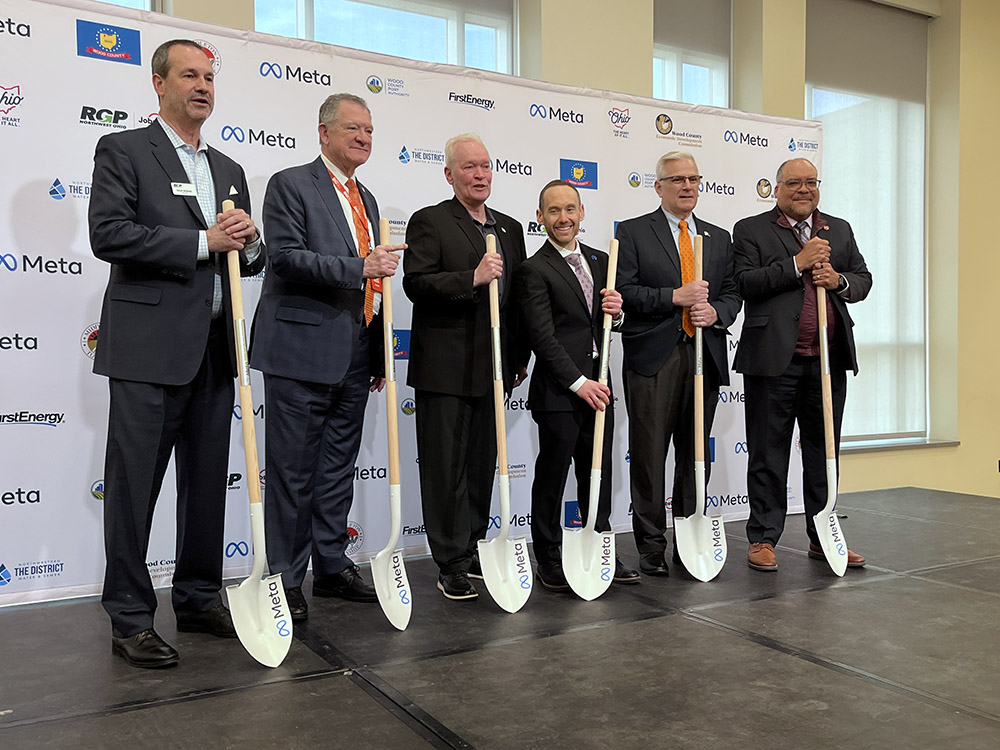
Davis said the data center will be “optimized for our AI workloads as part of a highly advanced infrastructure that helps connect millions of people” through Meta’s platforms, which include Facebook, Instagram, WhatsApp, and Threads.
“Our mission is to build the future of human connections,” Davis said.
This project will be Meta’s second data center in Ohio, following its investment in a New Albany facility that began in 2017.
Governor Mike DeWine, in a statement issued after the press conference, said that “Ohio is shaping the future of the data-driven digital economy, and we are pleased that Meta chose Wood County for this new investment. Northwest Ohio’s talent pipeline and strategic location will create an environment where Meta, and the other technology companies they attract, can thrive while bringing new opportunities for our regional workforce and their families.”
Bridges called Meta’s investment “transformational” for Northwest Ohio, and that “today’s announcement marks another milestone as Ohio embraces an emerging role as the Silicon Heartland.”
Bridges added that Ohio’s central location gives it a geographical advantage, with quick and easy access to interstate highways, rail networks and port facilities.
Combined with a “robust” electric grid and natural gas system, abundant water resources, and fiber-optic connectivity, “you have an ideal location for an environment for digital innovation,” Bridges said.
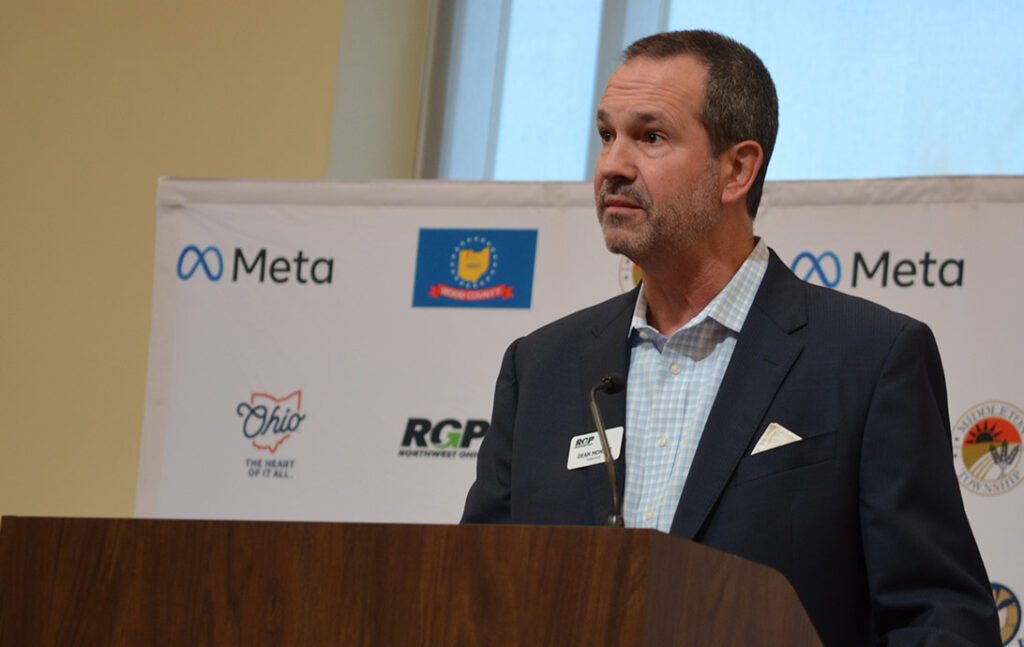
Dean Monske, president of the Regional Growth Partnership, which played a key role in bringing Meta to the area, said it was the local assets, not tax incentives, that drew the tech giant to Wood County, citing the availability of land, water and sewer, and electricity.
Wood County commissioners have granted Meta a 75 percent tax abatement for 15 years for the project.
Monske credited the success of landing the AI-optimized data facility to collaboration among elected officials, academia, the private sector, and state and regional economic development partners.
The project was kept under wraps, as much as possible, until Wednesday’s press conference. It was previously was referred to by the code name “Project Accordion” to conceal Meta’s involvement.
Ground was broken in October
Don Cromley and Mike Moulton, Middleton Township trustees, said the project has been under discussion for at least three years, and that ground was broken last October on Meta’s sprawling site, directly west of the Northwestern Water and Sewer District headquarters on SR 582, also known as Middleton Pike.
“There are 35 earth movers there now, and I don’t know how many excavators,” Moulton said.
“A big bonus is that the little town of Dunbridge is going to get sewer and water,” added Cromley.
The trustees said a water tower, paid for by Meta, is already being erected on the site. The data center will have access to up to 600,000 gallons of water a day.
“We are focused on sustainability,” Davis said. “The center will actually use a minimal amount of water, but obviously it’s a very important aspect of the project.”
Davis said Meta is proud that, like all of the company’s data centers, the Bowling Green facility’s use of electricity “will be matched with 100 percent clean and renewable energy.”
Bridges and Davis both pointed out that Meta plans to make millions of dollars in grants available to the local public school systems.
“Once this data center is open, we will launch our community action grants program, where we partner with schools and local organizations to put the power of technology to use for community benefits,” Davis said. “Once we’re online, we’re going to partner very closely with them and make sure they understand the grant process.”

Asked if there were any concerns that the data center might generate a lot of noise, Davis said no. “We feel good about how we operate. We want to show up in the right way, be good neighbors. We’re very cognizant of our neighbors and want to operate in their best interest. It’s important to us to be strong members of the community.
“Overall, this community has been tremendous. This $800 million investment will bring many more millions of dollars of economic activity to the area … all the things that the community has done to attract this project is really paying off now,” Davis said.
He said Meta is committed to the Wood County project no matter what happens with the tariffs recently imposed by Trump on imported products and the tariffs levied by foreign nations on U.S. goods.
Davis said Meta will be hiring people for a wide variety of jobs, including technicians, logistical workers, culinary and janitorial staff. He said jobs at the data center will be posted online at metacareers.com.

Diverse coalition recites Martin Luther King, Jr. anti-war speech

TOLEDO— An eclectic group united their voices at the Monroe Street United Methodist Church on April 6 to commemorate the anniversary of Beyond Vietnam: A Time to Break Silence, the famous anti-war speech delivered by Martin Luther King Jr.
One by one, individuals representing 50 different community organizations stepped to the microphone to solemnly proclaim King’s words calling for peace and justice. King gave the speech at Riverside Church in New York City on April 4, 1967 – one year to the day before he was assassinated.
Our Time to Break Silence has been held annually since 2017. The community reading is hosted by the church but organized by a committee representing a large coalition of individuals and organizations from the Toledo area.
Readers included representatives from Christian, Muslim and Jewish communities, the League of Women Voters, Lucas County Children Services, students from The University of Toledo and Toledo Public Schools, the Toledo-Lucas County Public Library, and many other nonprofit and advocacy groups.
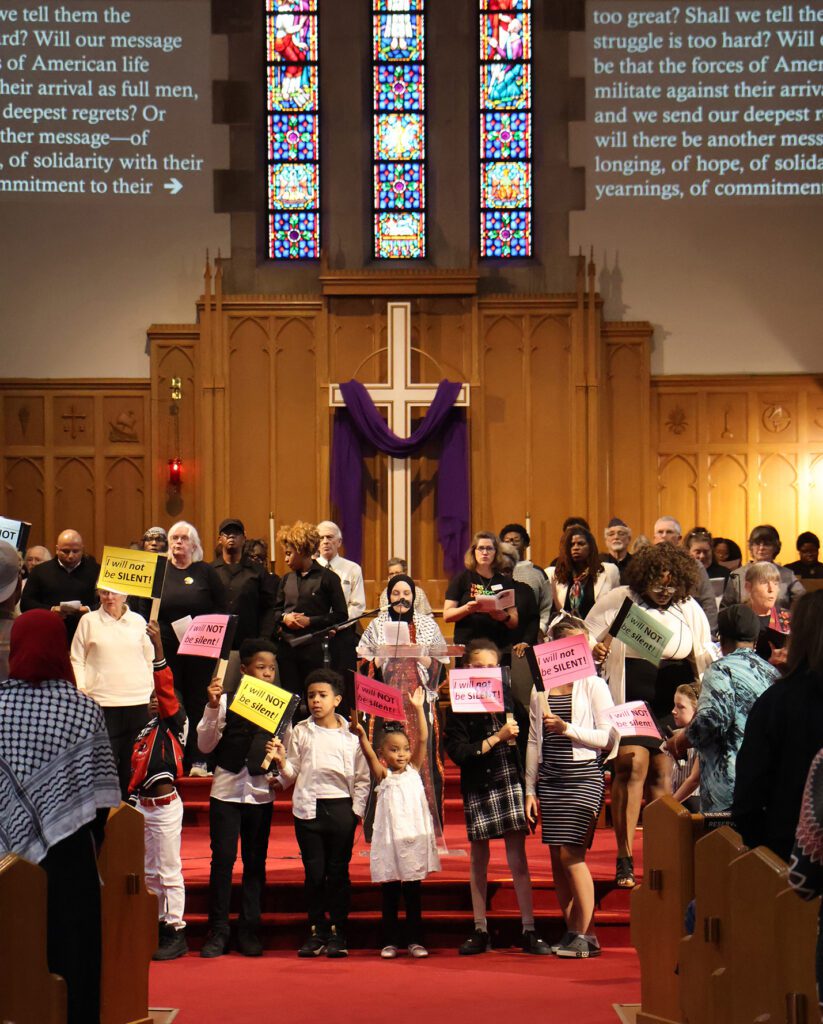
“I can personally say I have never been in a room with such a diverse group of people, and I think Dr. King’s message speaks to the fact that we are much stronger together than we will ever be apart,” said Marilyn DuFour, a member of the organizing committee and representative of Sacred Grounds Toledo.
“I think that’s what draws people to this event. It gives everyone an equal voice, and gives everybody an opportunity to share their own particular way of breaking silence,” she added.
Throughout the community reading, the crowd in attendance was encouraged to stand periodically to recite key lines expressing King’s message. Each of these passages was punctuated by the repetition of the phrase, “I will NOT be silent.”
Organizers drew parallels between the Vietnam War and other injustices of King’s day and those taking place now, including the war and devastation in Gaza.
“Even though it is no longer 1967, there are still travesties happening today that need to be spoken out against,” Vernita Lewis Taylor said during her introduction for the program.
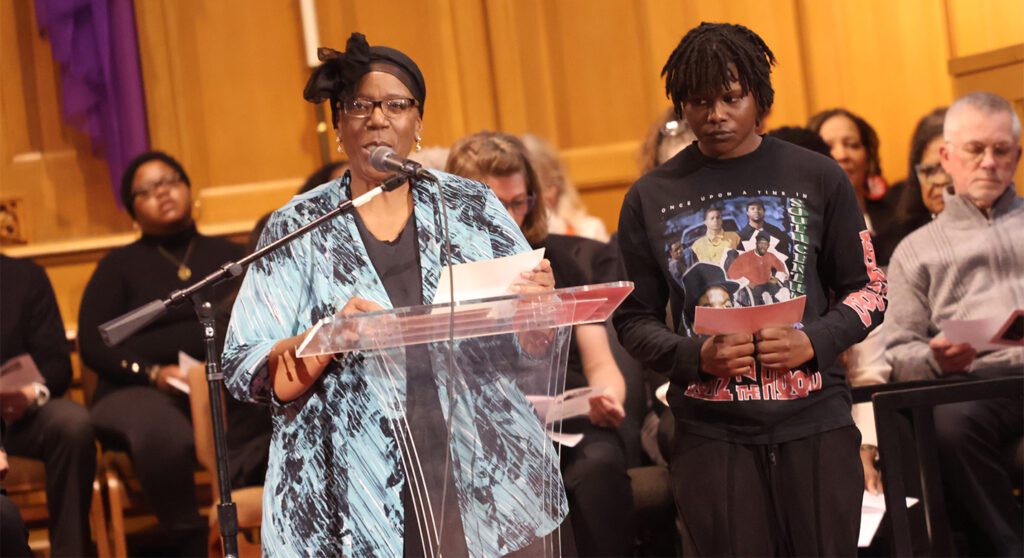
Lewis Taylor, an event co-chair who also works as an accountant for TPS, cited among her concerns the attacks on women’s rights and voting rights, the dismantling of diversity, equity and inclusion initiatives and the Department of Education.
She said the event is meant to ignite people to want to do something to make their own communities better, using King as a role model.
“What he’s doing in the speech is saying that we must bond together,” said Lynne Hamer, a member of Monroe Street United Methodist who started the event in 2017 and co-chairs the planning committee. She added that King cast a broad net in his speech when he called for the defeat of “the giant triplets of racism, extreme materialism and militarism.”
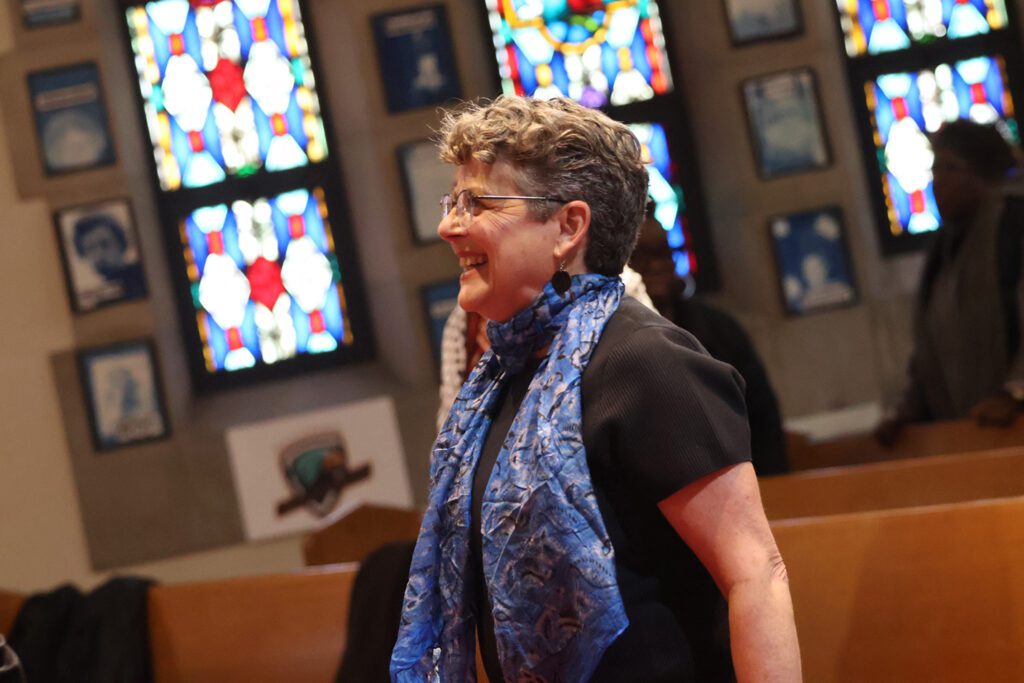
This year Hamer divided the speech into parts for 53 readers, trying as best she could to match excerpts with the priorities of the representative’s organization. “You hear the speech in its entirety in all of these different voices,” she said.
TPS has served as an event co-sponsor for the past several years. Students and administrators spoke during the program; artwork created by TPS students was on display around the church; and the Chamber Orchestra from Toledo School for the Arts performed “North Star to Freedom” by Soon Hee Newbold.
“It’s wonderful to have our students involved in this event, to show them that their voice does matter,” said Linda Ruiz-Bringman, the assistant superintendent of Student, Family and Community Engagement for TPS and a member of the event’s planning committee.
Stephenie Williams, a senior at Jones Leadership Academy of Business, said she was not familiar with King’s speech before she was asked to serve as a reader for this year’s event. She took her role seriously, noting that it was important not to read too fast or too slow.
“You got to let everybody hear the power that’s coming from you,” Williams said.
“Just to be part of something so moving, so inspirational, is something that I personally feel proud to be a part of,” she added.
Local vets join Flag City Honor Flight
SWANTON – Greeted by rounds of applause, grateful hearts and the United States Armed Forces Medley, 73 veterans returned from an all-expenses paid, one-day trip to Washington, D.C.
The Flag City Honor Flight (FCHF) veterans arrived home on Tuesday, April 1, to a Welcome Home ceremony attended by their families, FCHF volunteers and community members.
“It was probably the best day of my life,” said 25th Infantry Vietnam Veteran Donald Miller.
“The send-off and return were unbelievable, the music, the band, shaking hands,” Miller said. “It was like New Year’s Eve.”
This was the 30th flight the FCHF has taken. The FCHF, a nonprofit with a 100-percent volunteer force, makes four veteran flights annually. This year’s dates are April 1, June 3, Sept. 9 and Oct. 14.
More than just a fun vacation to the nation’s capital, this visit is an opportunity for veterans to attend the World War II, Korean and Vietnam war memorials.
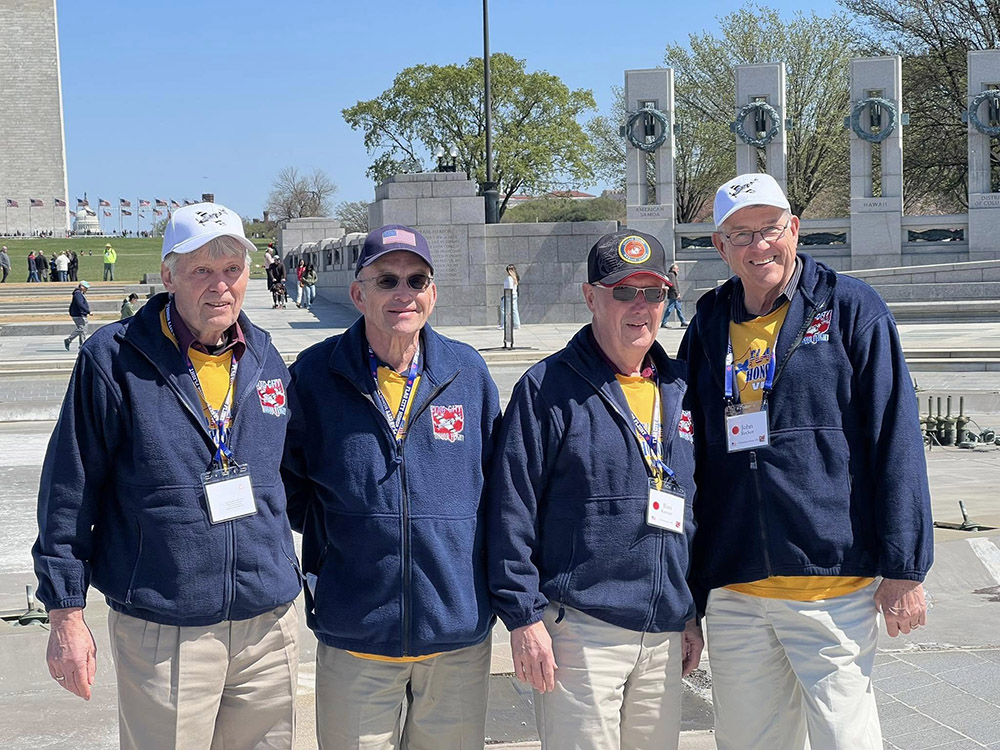
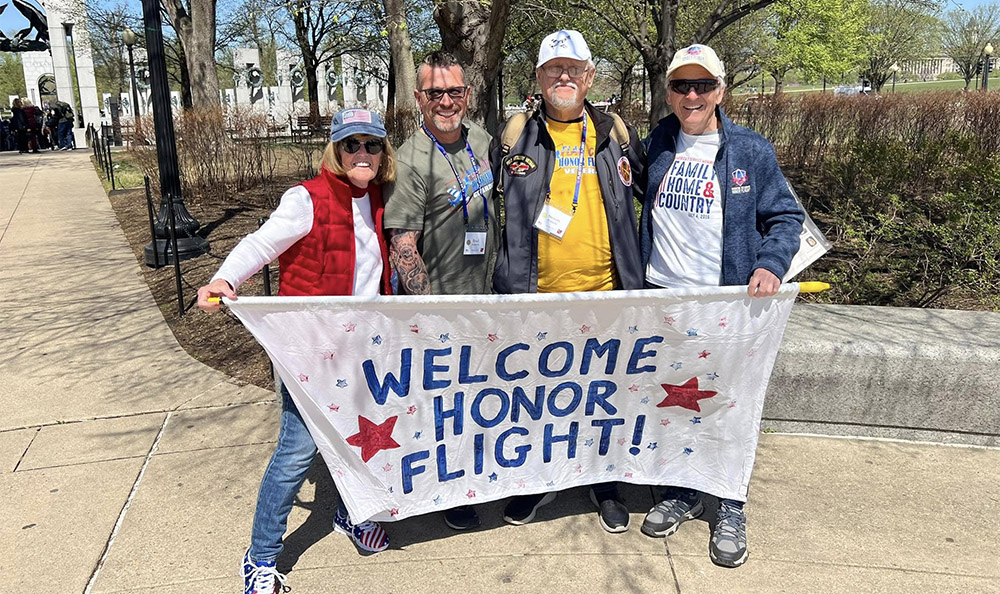
The 2025 trips will differ slightly from previous years, however.
While all flights still depart and return from Toledo Express Airport, they are using a new airline, JetBlue, rather than Allegiant.
FCHF media leader Mallory Crooks said this is to help save time. With Allegiant, veterans had to fly to Baltimore and take a long bus ride to the memorials. JetBlue provides a more direct route to the memorials.
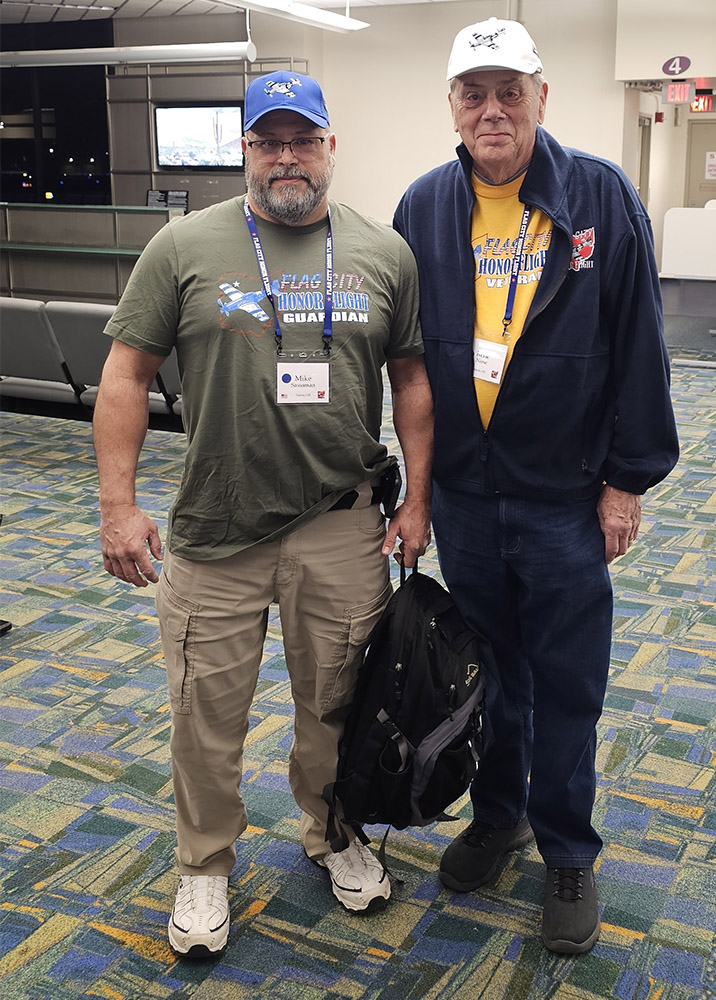
“Outstanding” was Vietnam veteran Rene Niese’s one-word response regarding his experience on the FCHF trip.
While Niese and Miller had each visited the national war memorials before, they agreed that seeing them on the trip with other veterans completely changed the experience.
“The Vietnam wall was my favorite,” Miller said. Miller’s cousin was killed during the war, and his name is inscribed on the Vietnam War Memorial.
Miller explained that while everybody looks at war memorials differently, to him, they are a celebration of life.
In addition to seeing memorials, the trip is also a chance for veterans to bond and connect.
For Niese, who was a battalion supply officer in Vietnam and a captain in the 359th Transportation Company, it was a chance to reconnect. He happened across one of his old high school classmates, who, unbeknown to Niese, had also served in Vietnam.
While the trip was attended by Korea veterans, as well, for the Vietnam veterans, being honored for their service was especially moving.
Warm welcomes were not especially common when soldiers returned home from Vietnam.
“Welcome homes then were mom and dad, and maybe a friend,” Miller said.
Niese said he also particularly enjoyed mail call. He recalled that during his deployment, he used to eagerly await letters or packages from his wife and family.
“We would wait, and they would call your name and give you your mail,” Niese said.
So, it was particularly moving during mail call at the Welcome Home ceremony. Niese received a mail bag filled with dozens of letters written by everyone from children to congressmen.
“I did not want it end,” he said.
In addition to the bag of mail, Niese also received a knitted red, white and blue blanket, which he plans to use while sitting on his porch chatting with his wife.
While the memorials are the primary focus of the trip, Crooks said veterans have opportunities to see more sights.

“This particular flight, we had four Flag City Honor Flight representatives lay a wreath at the tomb of the Unknown Soldier,” Crooks said.
Veterans also saw the changing of the guard at Arlington National Cemetery, and drove past the Navy and Air Force memorials.
Veterans in Northwest Ohio and Southeastern Michigan qualify for the FCHF flights.
“I’d highly recommend it to any veteran,” Miller said. “It’s really well worth it. Makes you feel good.”
Crooks said the FCHF is looking for volunteers and sponsorships to help fund the flights and keep them free for veterans. Learn more at flagcityhonorflight.org.



